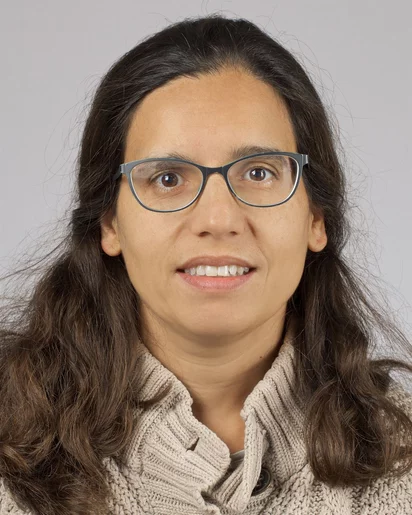Biography
Ana Diaz has dedicated her entire career to develop X-ray characterization methods using synchrotron radiation. She did her PhD at the Paul Scherrer Institute in Switzerland on the characterization of colloidal suspensions confined in unidimensional gratings and then moved to the European Synchrotron Radiation Facility in France to work as a postdoc, where she used Bragg coherent diffraction imaging to characterize epitaxial SiGe nanocrystalline structures. She is now back at the Paul Scherrer Institute where she works as a beamline scientist at the Swiss Light Source since 2009. Ana has contributed significantly to the implementation of hard X-ray ptychography at the cSAXS beamline, in particular for ptychographic tomography. Together with her colleagues, she has received the Helmoltz Zentrum Berlin Innovation Award on Synchrotron Radiation in 2014 for high-resolution 3D hard X-ray microscopy. Since 2022, she has been promoted to senior scientist at the Paul Scherrer Institute.
Institutional responsibilities
Commissioning and further development of experimental setups at the coherent small-angle X-ray scattering (cSAXS) beamline at the Swiss Light Source (SLS), research using synchrotron radiation, publication of results in specialized journals and presentation in conferences, user support at the cSAXS beamline at the SLS, and support of master students, PhD students and postdocs. Participation in internal and external committees.
Scientific research
Ana Diaz's main research interest is the application of x-ray ptychographic imaging for systems which can not be easily investigated with other microscopy techniques. Examples of such sytems are cryo x-ray microscopy of biological tissue and imaging of strain fields in nanocrystalline materials.
Publications
For an extensive overview we kindly refer you to our publication repository DORA and to Ana Diaz's ORCID and researcher ID I-4139-2013
High-performance 4-nm-resolution X-ray tomography using burst ptychography, T. Aidukas, N. W. Phillips, A. Diaz, E. Poghosyan, E. Müller, A. F. J. Levi, G. Aeppli, M. Guizar-Sicairos, M. Holler, Nature 632, 81-88 (2024) DOI: 10.1016/j.cemconres.2024.107622 A new record in hard X-ray microscopy achieved by ptychographic X-ray computed tomography. This achievement was possible thanks to two key developments: burst ptychography, in which several short-exposure diffraction patterns are recorded at each scanning step, and back propagation tomography, needed to overcome the depth of field limit.
High-resolution three-dimensional imaging of topological textures in nanoscale single-diamond networks, D. Karpov, K. Djeghdi, M. Holler, S. Narjes Adbollahi, K. Godlewska, C. Donnelly, T. Yuasa, H. Sai, U. B. Wiesner, B. D. Wilts, U. Steiner, M. Musya, S. Fukami, H. Ohno, I. Gunkel, A. Diaz, J. Llandro, Nat. Nanotech. (2024) DOI: 10.1038/s41565-024-01735-w High-resolution 3D imaging of self-assembled block copolymer structures replicated in gold allowed the investigation of long-range defects on the mesoscale. This gave valuable information for the understanding of self-assembly and its use for designing new materials.
Imaging of retina cellular and subcellular structures using ptychographic hard X-ray tomography, V. Panneels, A. Diaz, C. Imsand, M. Guizar-Sicairos, E. Müller, A. G. Bittermann, T. Ishikawa, A. Menzel, A. Kaech, M. Holler, C. Grimm, G. Schertler, J. Cell. Sci. 134, jsc258561 (2021), DOI: 10.1242/jcs.258561 This work explores the use of ptychographic tomography for the structural characterization of resin-embedded, stained retina tissue at a spatial resolution of around 100 nm. The three-dimensional images reveal cellular and sub-cellular structures including axons and synapses.
X-ray ptychographic topography: A robust nondestructive tool for strain imaging, M. Verezhak, S. van Petegem, A. Rodriguez-Fernandez, P. Godard, K. Wakonig, D. Karpov, V. L. R. Jacques, A. Menzel, L. Thilly, A. Diaz, Phys. Rev. B 103, 144107 (2021), DOI: 10.1103/PhysRevB.103.144107 This new method is an innovative approach to image strain and defects in extended crystalline samples with a spatial resolution well below 100 nm. It makes use of a plane-wave illumination to reconstruct the wavefront after propagation through the specimen in diffraction condition.
Three-dimensional mass density mapping of cellular ultrastructure by ptychographic X-ray nanotomography, A. Diaz, B. Malkova, M. Holler, M. Guizar-Sicairos, E. Lima, V. Panneels, G. Pigino, A. G. Bittermann, L. Wettstein, T. Tomizaki, O. Bunk, G. Schertler, T. Ishikawa, R. Wepf, A. Menzel, J. Struct. Biol. 192, 461 (2015), DOI: 10.1016/j.jsb.2015.10.008 First demonstration of ptychographic tomography on frozen hydrated biological cells, this work paved the way to subsequent nanotomography of frozen hydrated biological tissue extending several tens of micrometers in each dimension with quantitative phase contrast. The latter allows the absolute measurement of the mass density of different cellular compartments, which can be an important analytical tool for biologists. This was demonstrated here using Chlamydomonas cells as a model of a biological sample.
